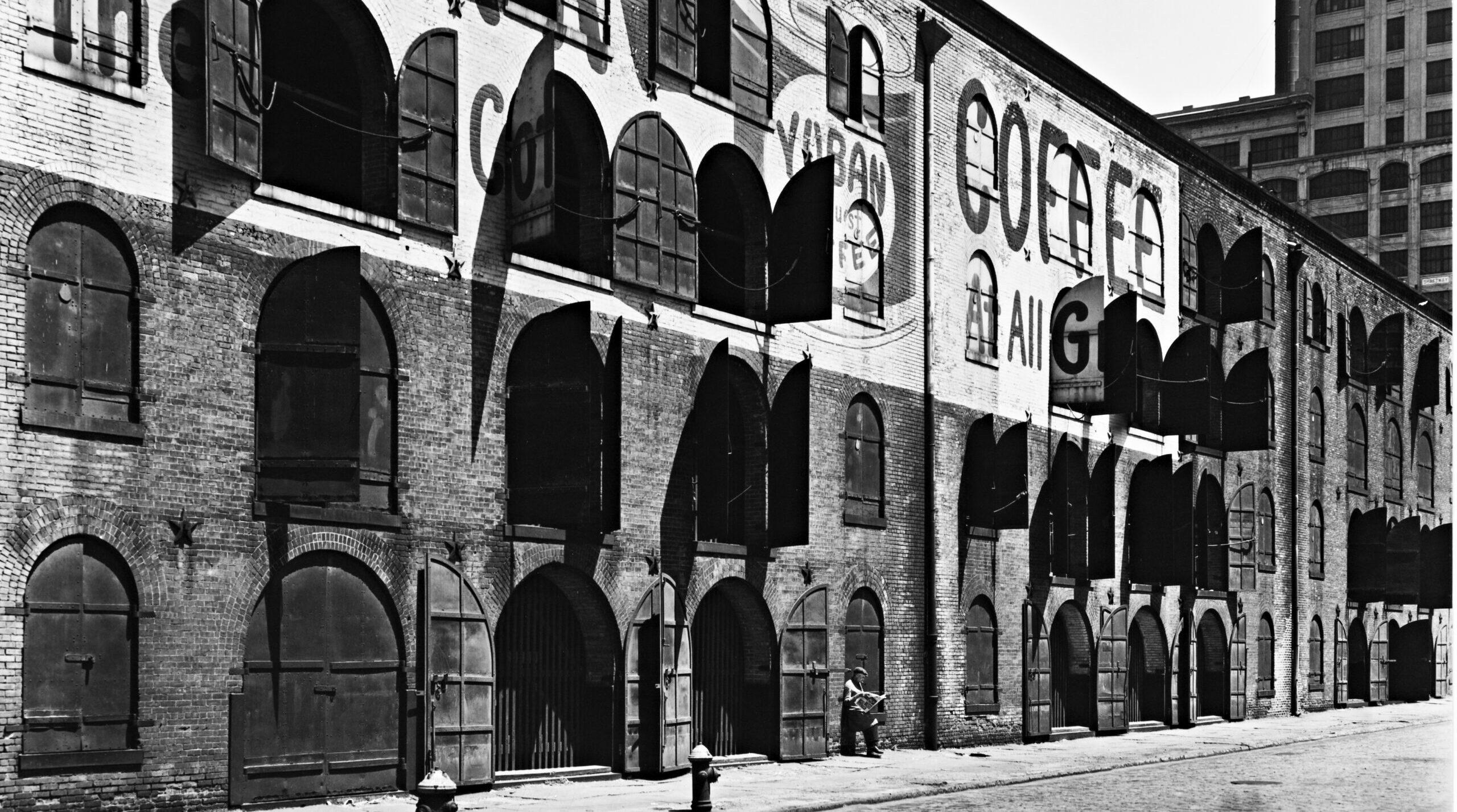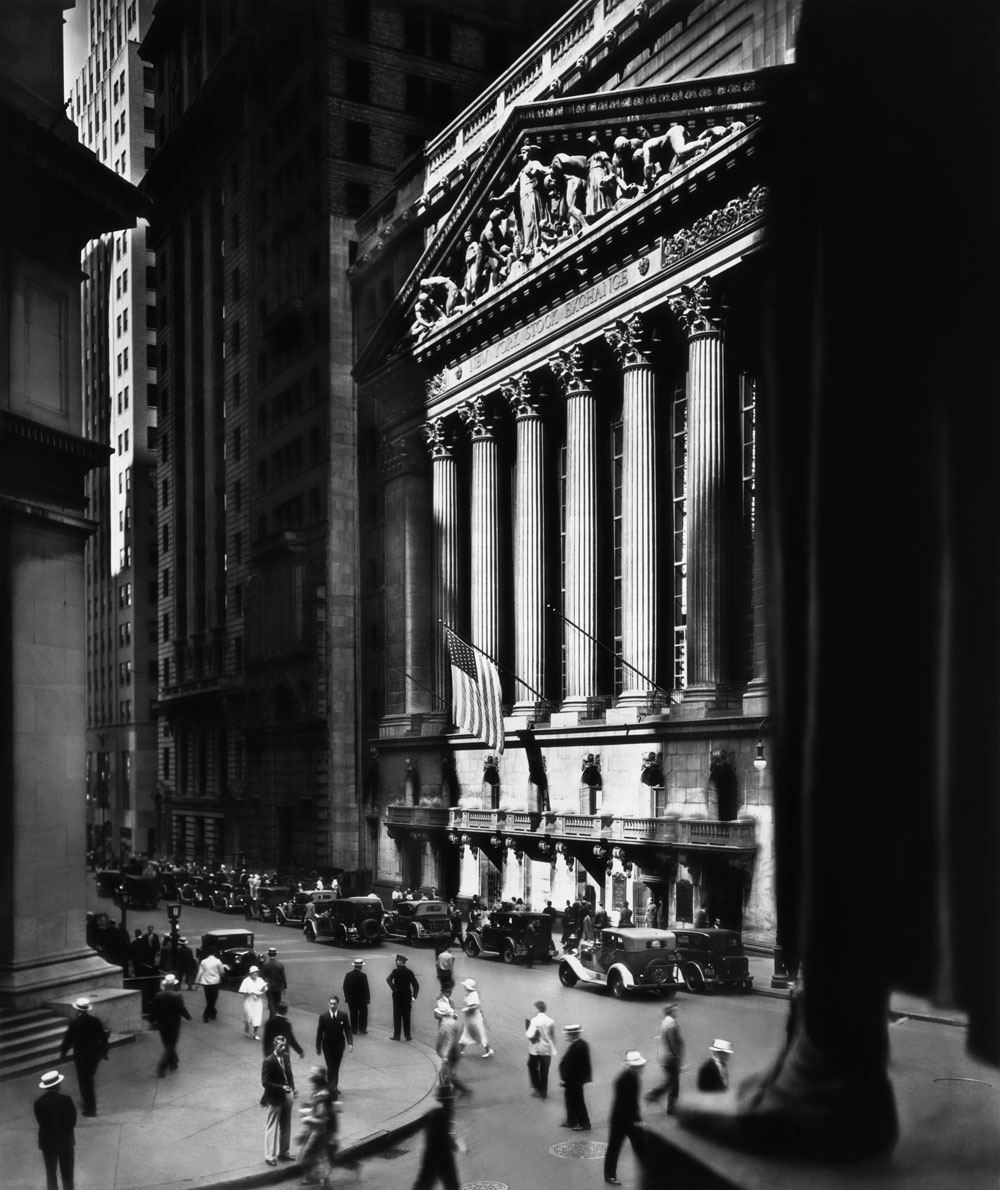Berenice Abbott (American, 1898–1991), Warehouse, Water and Dock Streets, 1936. Gelatin silver print. Cantor Arts Center, Stanford University. Gift of Daniel Mattis.
Remembered as one of the most independent, determined and respected photographers of the 20th century, Berenice Abbott chronicled the evolution of New York City for decades beginning with the Great Depression.
Images of iconic New York City landmarks such as
the New York Stock Exchange (est. $3,000-5,000),
the construction of Rockefeller Center (est. $1,500-2,500)
and Broadway to the Battery ($1,000-2,000) (below)highlight this collection of original prints.
"Berenice Abbott spent years chronicling the evolution of New York City. She captured the architecture, the people and the spirit of one of the busiest, most dynamic and influential cities in the world. Many of these prints capture iconic images of the New York City from Abbott's creative perspective but still with a dramatic effect that stands the test of time," said Nigel Russell, Heritage Auctions Director of Photography.
Heritage Auctions will be hosting a reception from 6-8 p.m. May 11 at the New York Office located at 445 Park Avenue at 57th street. Julia Van Haaften - who has written a biography Berenice Abbott: A Life in Photography which is to be published by W.W. Norton in April 2018 will speak about Abbott's impact and significance.
The class of 2000 International Photography Hall of Fame inductee began her photography career in Paris as a darkroom assistant working with visual artist Man Ray in the 1920s. She soon realized she had an eye for taking photos, as well as developing them, and quickly built a sizable client base of portrait subjects. Abbott had her first solo exhibition in 1926 at the Jan Slivinsky Gallery entitled Portraits Photographiques. The show received rave reviews and Abbott returned to New York in February 1929.
Upon returning to New York City, Abbott quickly recognized what her next project should entail. Influenced by Eugene Atget, the pioneering documentary photographer, Abbott realized that New York City had grown tremendously while she was away and she needed to capture "old New York" from every aspect. The city became her subject and her work appeared in Vanity Fair, The Saturday Review of Literature, the Saturday Evening Post, Theater Guild Magazine and Fortune.
According to her online biography, Abbott favored a straightforward, yet dynamic, style that featured strong contrasts and dramatic angles. "Photography can never grow up if it imitates some other medium," Abbott said. "It has to walk alone. It has to be itself."
Many of the photographs offered are from her almost 10 years of documenting New York City, which eventually were published in a book entitled Changing New York.
• Works in the Photographs Signature Auction include but are not limited to:
Berenice Abbott (American, 1898-1991), Broadway to the Battery, May 4, 1938. Gelatin silver, 9-1/2 x 7-1/4 inches. Estimate: $1,000 - $2,000.
• Canyon: Broadway and Exchange Place, July 16, 1936 (est. $4,000-6,000)
• Newsstand, Southwest Corner of 32nd Street and Third Avenue, November 19, 1935 (est. $2,000-3,000)
• Tempo of the City II, Fifth Avenue and 42nd Street, May 13, 1938 (est. $1,000-2,000)
• Trolley Car, Times Square, New York, 1936 (est. $2,000-3,000)
• Under the "El" at the Battery, New York, 1936 (est. $1,000-2,000)
Berenice Abbott’s 1929 Photographic Album of New York City Opens at The Met March 2 |
|
|
 |
Opening at The Metropolitan Museum of Art on March 2, 2023, Berenice Abbott’s New York Album, 1929 will present selections from a unique unbound album of photographs of New York City created by American photographer Berenice Abbott (1898–1991), shedding light on the creative process of one of the great artists of the 20th century. Consisting of 266 small black-and-white prints arranged on 32 pages, the album is a kind of photographic sketchbook that offers a rare glimpse of an artist’s mind at work. In addition to some 25 framed album pages, the exhibition will feature photographs from The Met collection of Paris streets by Eugène Atget, whose archive Abbott purchased and promoted; views of New York by her contemporaries Walker Evans and Margaret Bourke-White; and selections from Abbott’s grand documentary project, Changing New York (1935–39).
The exhibition is made possible by The Robert Mapplethorpe Foundation, Inc.
"Berenice Abbott's groundbreaking work in photography continues to inspire and captivate audiences today, nearly a century after she first began documenting the world around her," said Max Hollein, Marina Kellen French Director of The Met. "Abbott's insightful and powerful images provide a window into the New York of the past, while also reminding us of the city's enduring vitality and resilience."
Born in Ohio, Abbott moved to New York City in 1918 and to Paris in 1921. She learned photography as a darkroom assistant in Man Ray’s studio and soon established herself as a prominent portraitist of the Parisian avant-garde. Through Man Ray, Abbott met the aging French photographer Eugène Atget, whose documentation of Paris and its environs struck her as a model of modern photographic art. Following Atget's sudden death in 1927, she purchased his archive of some 8,000 prints and 1,500 glass negatives and set about promoting his work through exhibitions and publications.
In January 1929, after eight years in Europe, Abbott boarded an ocean liner to New York City for what was intended to be a short visit. Upon arrival, she found the city transformed and ripe with photographic potential. “When I saw New York again, and stood in the dirty slush, I felt that here was the thing I had been wanting to do all my life,” she recalled. Inspired by Atget, Abbott traversed the city with a handheld camera, photographing its skyscrapers, storefronts, bridges, elevated trains, and neighborhood street life. She pasted these "notes" into a standard black-page album, arranging them by subject and locale. As the immediate precursor to her 1930s WPA project, Changing New York, Abbott's New York album marks a key moment of transition in her career: from Europe to America and from studio portraiture to urban documentation. The exhibition will be accompanied by an online feature that identifies, for the first time, the locations of many of the photographs in the album.
Berenice Abbott’s New York Album, 1929 is organized by Mia Fineman, Curator in the Department of Photographs, with assistance from Virginia McBride, Research Assistant in the Department of Photographs, both at The Met.
The exhibition is featured on the Museum's website, as well as on social media using the hashtag #AbbottNYC.
Jacob Heymann Butcher Shop, 345 Sixth Avenue near West 4th Street, June 15, 1927. Berenice Abbott via MCNY.
|
|





No comments:
Post a Comment